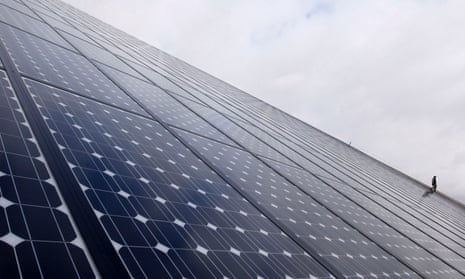Welcome to the post-Renewable Energy Target (RET) twilight zone, where Australia’s biggest polluters are also apparently its biggest champions of renewable energy.
But don’t bother looking out your plane window for a gremlin on the wing – this is just the topsy-turvy world of today’s Australian energy market, where some of our biggest power companies have decided they’d rather sell spin than cleaner energy.
It’s been a month since the dust settled on the all-in-brawl over the RET and, having lobbied for and won a cut to protect their vested interests in dirty power, AGL and Origin are doing all they can to “prove” they walk the walk when it comes to renewables.
This includes subjecting the public to a punishing stream of announcements, social media posts and everything from adverts on buses to multimillion-dollar commercials, all designed to spruik their green credentials and endear themselves to wary consumers.
The hypocrisy is breath-taking.
Just months ago, both companies argued for the RET to be slashed, despite the fact it was bringing electricity prices down and supercharging green energy investment.
AGL is perhaps the worst offender, spreading pro-renewable furphies through Facebook and Twitter while assuring investors sotto voce they mean nothing of the sort.
The company gets a lot of social media mileage out of their claim to be Australia’s biggest investor in renewables, and, in fairness, they’ve put $3bn into the sector over the last five years.
That number is less impressive when you discover they’ve also invested at least $2.4bn in coal over the same period, including a whopping $1.5bn on Macquarie Generation just last year in a deal that catapulted them into top spot as the country’s biggest polluter.
You’ve got to admire the chutzpah. It’s a bit like McDonald’s claiming to be the biggest contributor to kids’ fitness while churning out enough artery-clogging Happy Meals to fill the Grand Canyon.
But while AGL’s customers are love bombed with images of solar farms and feel-good stories about renewable energy, investors get the real scoop.
The company’s May 2015 briefing to the ASX said the RET was “unlikely to deliver further investment due to financing constraints.”
This view was restated in an academic journal in June by AGL’s head of sustainability, Tim Nelson, who wrote “in our view, achievement of the RET (at any meaningful level) appears impossible”. Hardly ringing endorsements of the policy their marketing team claims they support.
On a larger scale, in April the company announced with some fanfare that they would be phasing out their dirty coal operations by 2050.
Sounds good until you realise their coal-fired generators are scheduled to be retired by then anyway, with their monstrous Loy Yang A plant in Victoria scheduled for decommission in 2048, making their 2050 target more of a rounding error than a line in the sand.
Meanwhile, AGL clearly intends to plough more money into the coal-fired assets that dominate their portfolio, with capital expenditure set to remain in the millions of dollars over the coming years.
Competitor Origin Energy, also one of the country’s biggest polluters, has launched a parallel shock and awe campaign to convince us they’re actually the good guys when it comes to renewables.
Origin’s social media is dominated by touchy-feely renewable energy posts, with that approach hammered home in their slick “Energy Made Fresh Daily” solar leasing campaign.
Bear in mind, this is a company that derives a measly 1 per cent of their energy from renewables, that lobbied for the RET to be cut nearly in half, and for subsidies for solar panels to be scrapped entirely.
It really didn’t have to be this way, for AGL in particular.
As late as 2012, the company chaired the Clean Energy Council and was the country’s most vocal supporter of the RET, arguing a reduction would harm investment and increase household energy bills.
AGL may have changed their tune, but the Australian public certainly haven’t.
Over 1.5 million people have already reduced their reliance on big energy companies by installing rooftop solar, while entire communities are banding together to form independent, community-owned energy projects.
The energy revolution is about to start hitting its straps. Battery and thermal storage capacity are about to become a commercially affordable reality and, led by the Tesla Powerwall, this will change things dramatically over the next 10 years, allowing many households to disengage from the grid altogether.
Right now more than 12,000 people have taken direct action through GetUp’s Better Power campaign, switching from dirty power providers to a company with strong commitments to the RET, renewable energy investment and a clean, modern and cheaper energy sector.
The rest of the world has figured out renewable energy is the future and so have AGL and Origin Energy’s customers. If they don’t stop being part of the problem they risk being left behind with billions of dollars of stranded coal assets and armfuls of their own marketing greenwash, stuck in a twilight zone of their own creation.
